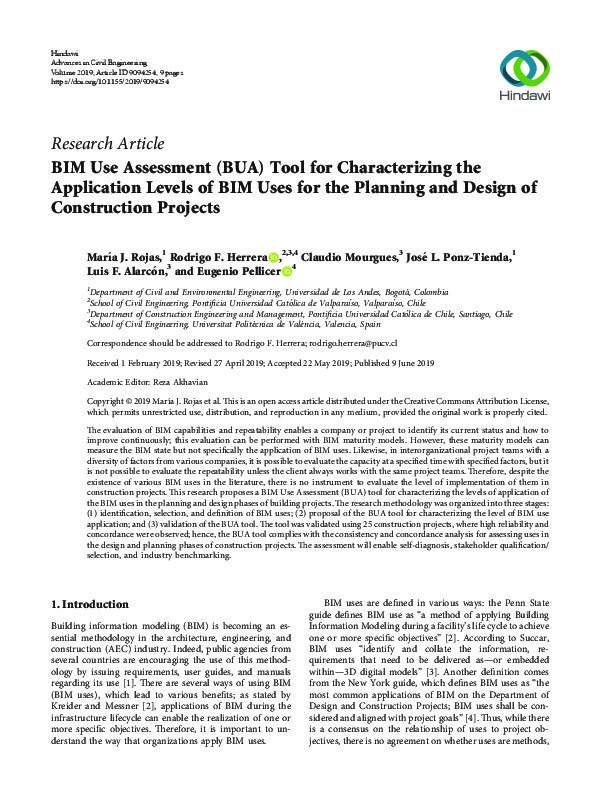JavaScript is disabled for your browser. Some features of this site may not work without it.
Buscar en RiuNet
Listar
Mi cuenta
Estadísticas
Ayuda RiuNet
Admin. UPV
BIM Use Assessment (BUA) Tool for Characterizing the Application Levels of BIM Uses for the Planning and Design of Construction Projects
Mostrar el registro sencillo del ítem
Ficheros en el ítem
| dc.contributor.author | Rojas, María José
|
es_ES |
| dc.contributor.author | Herrera, Rodrigo F.
|
es_ES |
| dc.contributor.author | Mourgues, Claudio
|
es_ES |
| dc.contributor.author | Ponz-Tienda, José Luis
|
es_ES |
| dc.contributor.author | Alarcón, Luis F.
|
es_ES |
| dc.contributor.author | Pellicer, Eugenio
|
es_ES |
| dc.date.accessioned | 2020-06-05T03:33:21Z | |
| dc.date.available | 2020-06-05T03:33:21Z | |
| dc.date.issued | 2019-06-09 | es_ES |
| dc.identifier.issn | 1687-8086 | es_ES |
| dc.identifier.uri | http://hdl.handle.net/10251/145424 | |
| dc.description.abstract | [EN] The evaluation of BIM capabilities and repeatability enables a company or project to identify its current status and how to improve continuously; this evaluation can be performed with BIM maturity models. However, these maturity models can measure the BIM state but not specifically the application of BIM uses. Likewise, in interorganizational project teams with a diversity of factors from various companies, it is possible to evaluate the capacity at a specified time with specified factors, but it is not possible to evaluate the repeatability unless the client always works with the same project teams. Therefore, despite the existence of various BIM uses in the literature, there is no instrument to evaluate the level of implementation of them in construction projects. This research proposes a BIM Use Assessment (BUA) tool for characterizing the levels of application of the BIM uses in the planning and design phases of building projects. The research methodology was organized into three stages: (1) identification, selection, and definition of BIM uses; (2) proposal of the BUA tool for characterizing the level of BIM use application; and (3) validation of the BUA tool. The tool was validated using 25 construction projects, where high reliability and concordance were observed; hence, the BUA tool complies with the consistency and concordance analysis for assessing uses in the design and planning phases of construction projects. The assessment will enable self-diagnosis, stakeholder qualification/selection, and industry benchmarking. | es_ES |
| dc.description.sponsorship | This work was supported by FONDECYT (1181648 to Alarcón L. F. and Mourgues C.) and CONICYT, Chile (PCHA/National Doctorate/2018-21180884 to Herrera R. F.). | es_ES |
| dc.language | Inglés | es_ES |
| dc.publisher | Hindawi Limited | es_ES |
| dc.relation.ispartof | Advances in Civil Engineering | es_ES |
| dc.rights | Reconocimiento (by) | es_ES |
| dc.subject.classification | CONSTRUCCIONES ARQUITECTONICAS | es_ES |
| dc.subject.classification | PROYECTOS DE INGENIERIA | es_ES |
| dc.title | BIM Use Assessment (BUA) Tool for Characterizing the Application Levels of BIM Uses for the Planning and Design of Construction Projects | es_ES |
| dc.type | Artículo | es_ES |
| dc.identifier.doi | 10.1155/2019/9094254 | es_ES |
| dc.relation.projectID | info:eu-repo/grantAgreement/CONICYT//2018-21180884/ | es_ES |
| dc.relation.projectID | info:eu-repo/grantAgreement/FONDECYT//1181648/ | es_ES |
| dc.rights.accessRights | Abierto | es_ES |
| dc.contributor.affiliation | Universitat Politècnica de València. Departamento de Construcciones Arquitectónicas - Departament de Construccions Arquitectòniques | es_ES |
| dc.contributor.affiliation | Universitat Politècnica de València. Departamento de Ingeniería de la Construcción y de Proyectos de Ingeniería Civil - Departament d'Enginyeria de la Construcció i de Projectes d'Enginyeria Civil | es_ES |
| dc.description.bibliographicCitation | Rojas, MJ.; Herrera, RF.; Mourgues, C.; Ponz-Tienda, JL.; Alarcón, LF.; Pellicer, E. (2019). BIM Use Assessment (BUA) Tool for Characterizing the Application Levels of BIM Uses for the Planning and Design of Construction Projects. Advances in Civil Engineering. 2019:1-9. https://doi.org/10.1155/2019/9094254 | es_ES |
| dc.description.accrualMethod | S | es_ES |
| dc.relation.publisherversion | https://doi.org/10.1155/2019/9094254 | es_ES |
| dc.description.upvformatpinicio | 1 | es_ES |
| dc.description.upvformatpfin | 9 | es_ES |
| dc.type.version | info:eu-repo/semantics/publishedVersion | es_ES |
| dc.description.volume | 2019 | es_ES |
| dc.relation.pasarela | S\389212 | es_ES |
| dc.contributor.funder | Fondo Nacional de Desarrollo Científico y Tecnológico, Chile | es_ES |
| dc.contributor.funder | Comisión Nacional de Investigación Científica y Tecnológica, Chile | es_ES |
| dc.description.references | Azhar, S. (2011). Building Information Modeling (BIM): Trends, Benefits, Risks, and Challenges for the AEC Industry. Leadership and Management in Engineering, 11(3), 241-252. doi:10.1061/(asce)lm.1943-5630.0000127 | es_ES |
| dc.description.references | Succar, B., Sher, W., & Williams, A. (2012). Measuring BIM performance: Five metrics. Architectural Engineering and Design Management, 8(2), 120-142. doi:10.1080/17452007.2012.659506 | es_ES |
| dc.description.references | Sydow, J., & Braun, T. (2018). Projects as temporary organizations: An agenda for further theorizing the interorganizational dimension. International Journal of Project Management, 36(1), 4-11. doi:10.1016/j.ijproman.2017.04.012 | es_ES |
| dc.description.references | McHugh, M. L. (2012). Interrater reliability: the kappa statistic. Biochemia Medica, 276-282. doi:10.11613/bm.2012.031 | es_ES |








